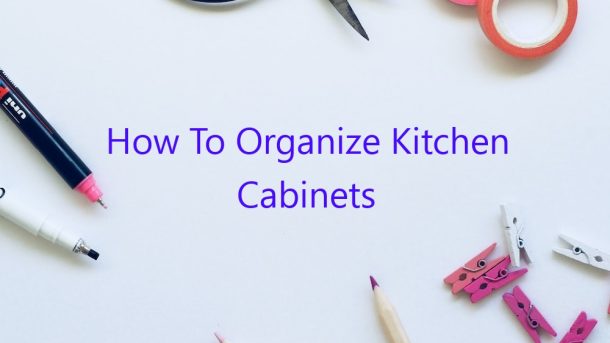Are you feeling overwhelmed when you walk into your kitchen? Do you feel like you can’t find anything in your cabinets? If so, it may be time to organize your kitchen cabinets.
There are a few different ways that you can go about organizing your cabinets. One way is to organize them by type of item. For example, you could have a section for pots and pans, a section for plates and bowls, and a section for cups and mugs.
Another way to organize your cabinets is to organize them by the frequency with which you use the items. This may be a little more difficult to do, but it can be a great way to maximize the space in your cabinets.
No matter how you choose to organize your cabinets, there are a few tips that can help make the process a little easier.
1. Start by emptying your cabinets. This will give you a good idea of what you have and what you need to organize.
2. Group similar items together. This will make it easier to find what you are looking for.
3. Label the shelves or containers that you use to organize your cabinets. This will help you remember where everything goes.
4. Use drawer organizers to organize your cabinets. This will help you keep everything in its place.
5. Keep a list of the items that are in your cabinets. This will come in handy when you need to buy something new.
Organizing your kitchen cabinets can be a daunting task, but it is definitely worth it in the end. By following these tips, you can create a system that works for you and your kitchen.
Contents
How do you decide where to put things in kitchen cabinets?
One of the biggest decisions you’ll make when renovating your kitchen is where to put everything. Cabinets can be customized to fit your needs, but you still need to figure out what goes where. Here are a few tips to help you out.
Start by determining how much storage you’ll need. This will depend on the size of your kitchen and how much you cook. If you have a small kitchen, you’ll need to be more selective about what you put in your cabinets.
Think about what you use most often and put those items within easy reach. This might include pots and pans, utensils, or spices. If you have a lot of dishes, you might want to put those in cabinets near the dishwasher.
It’s also important to think about how you use your kitchen. If you like to cook, you’ll need more storage for pots and pans. If you like to bake, you’ll need more storage for ingredients and baking dishes.
Consider the height of your cabinets and the size of your pots and pans. You don’t want to have to stack your pots and pans to reach the top shelf.
Finally, think about the décor of your kitchen. You want your cabinets to match the rest of your kitchen. If you have a modern kitchen, you’ll want modern cabinets. If you have a traditional kitchen, you’ll want traditional cabinets.
What are the 9 steps in organizing kitchen cabinets?
There is no one definitive answer to this question. Different people may have different ways of organizing their kitchen cabinets, based on their own personal preferences and needs. However, there are some general steps that can be followed in order to effectively organize kitchen cabinets.
1. Remove everything from the cabinets and shelves. This will give you a clear view of what needs to be organized and will make it easier to put things back in an orderly fashion.
2. Sort the items into categories. This could include things like dishes, pots and pans, utensils, food, and cleaning supplies.
3. Create a system for storing the items. This could involve using baskets or bins to corral like items together, or using labels to indicate where each item belongs.
4. Put the dishes and glasses back in the cabinets. They can be stored in the same place each time, or you could create a system where each type of dish is stored in a different place.
5. Hang pots and pans on hooks or use a pot rack to free up cabinet space.
6. Store utensils in a drawer or a utensil caddy.
7. Use a lazy Susan or stackable shelves to store food items.
8. Store cleaning supplies under the sink or in a cabinet.
9. Re-organize as needed. The kitchen is a constantly-evolving space, so it’s important to be willing to adapt and change the organization as needed.
How do you arrange dishes in kitchen cabinets?
How you choose to organize your dishes in your kitchen cabinets can make a big difference in how your kitchen functions. There are many different ways to do it, so find the method that works best for you.
One popular way to organize dishes is by type. You can group all of your plates together, all of your cups together, and so on. This can be convenient if you need to grab a specific type of dish quickly. However, this method can take up a lot of cabinet space.
Another popular way to organize dishes is by usage. You can group all of your plates together, all of your cups together, and all of your bowls together. This can be convenient if you want to grab a dish for a specific purpose. However, this method can also take up a lot of cabinet space.
A third way to organize dishes is by color. This can be a fun way to add a little bit of personality to your kitchen. It can also be convenient if you want to grab a dish quickly, as you can just grab a dish from the cabinet that matches the color of your outfit. However, this method can also take up a lot of cabinet space.
The best way to organize dishes in your kitchen cabinets is to find a method that works for you and your lifestyle. Try out a few different methods and see which one makes your life easier.
What is the most efficient way to organize a kitchen?
There is no one-size-fits-all answer to the question of how best to organize a kitchen, as the most efficient way to do so will vary depending on the specific layout and needs of the individual space. However, there are some general tips that can help you optimize your kitchen for efficiency.
One of the most important things to consider when organizing a kitchen is how you use it. Are you a cook who likes to have all of their ingredients and tools at their fingertips, or do you prefer to have everything in its place and only use certain areas of the kitchen for cooking? Knowing how you use your kitchen will help you to decide where to put things and how to set up your work areas.
If you are a cook who likes to have everything at their fingertips, you will want to consider installing a kitchen island or peninsula. This will give you a designated space for food preparation and cooking, and will allow you to keep your ingredients and tools close at hand. If you have a lot of counter space, you can also consider creating a designated area for food prep, with storage for pots and pans, utensils, and ingredients nearby.
If you prefer to have everything in its place, you will want to consider using cabinets and drawers to store your pots, pans, utensils, and ingredients. You can also use racks and hooks to organize your pots and pans, and install shelves or cabinets above your stove to store spices and other kitchen essentials.
No matter how you choose to organize your kitchen, be sure to keep things clean and tidy. This will help to ensure that you can work quickly and efficiently in your space.
What are the 10 steps in organizing kitchen cabinets?
If you’re like most people, your kitchen cabinets are filled with a variety of items – some that you use on a regular basis, and others that you don’t touch for months at a time. This can make it difficult to find what you need when you need it, and can also make your kitchen look cluttered.
One of the best ways to remedy this is to organize your kitchen cabinets. This can be a daunting task, but by following these 10 simple steps, you can have your cabinets organized in no time:
1. Declutter your cabinets. The first step in organizing your cabinets is to declutter them. This means getting rid of anything that you don’t use on a regular basis.
2. Create categories. Once you’ve decluttered your cabinets, create categories for the items that remain. This could include things like pots and pans, utensils, plates, cups, and so on.
3. Assign a place for each category. Once you have your categories, assign a place for each one. This could mean putting pots and pans on a shelf, utensils in a drawer, and plates and cups on a shelf.
4. Label each category. Once you’ve assigned a place for each category, label each one. This will help you remember where everything goes.
5. Put the most-used items in the easiest-to-reach places. The items that you use the most should be placed in the easiest-to-reach places. This could mean putting pots and pans on the bottom shelf of a cabinet, utensils in the front of a drawer, and so on.
6. Group similar items together. Another way to make it easier to find what you need is to group similar items together. This could mean putting all of your plates in one spot, all of your cups in another spot, and so on.
7. Store bulky items on the bottom. Bulky items like pots and pans take up a lot of space, so it’s best to store them on the bottom of a cabinet. This will free up space for other items.
8. Use drawer dividers. If you have a lot of utensils, you can use drawer dividers to organize them. This will keep them from becoming cluttered and make it easier to find what you need.
9. Use storage containers. Storage containers can be a great way to organize small items like spices and baking supplies. They can also help keep your cabinets clean and clutter-free.
10. Keep a cleaning supplies close by. It’s a good idea to keep a cleaning supplies close by so that you can quickly clean your cabinets when they get dirty.
What goes in first the floor or the cabinets?
There are a few things to consider when deciding what goes in first: the floor or the cabinets.
One of the main things to consider is the weight of the cabinets. If you have a lot of weight in the cabinets, it is important to put the floor in first so that it can support the weight.
Another thing to consider is the installation process. If the cabinets are going to be installed first, it is important to put the floor in so that it can be protected from damage.
There are also a few other things to consider, such as the layout of the room and the type of flooring you are using.
In general, it is usually best to put the floor in first. However, there are a few exceptions, so it is important to consider all of the factors involved.
What are the four basic kitchen layout?
Layout is one of the key considerations when designing or remodeling a kitchen. There are a variety of layouts to choose from, but the four most common are U-shaped, L-shaped, galley, and peninsula. Let’s take a look at each one.
U-shaped kitchens are the most popular layout. They have a lot of counter space and storage, and they’re perfect for multiple cooks. The downside is that they can be cramped and difficult to move around in.
L-shaped kitchens are also popular. They offer more counter space and storage than U-shaped kitchens, and they’re more spacious. However, they can be difficult to use if the two sections of the “L” are too far apart.
Galley kitchens are the most efficient layout, with all the appliances and storage in a straight line. This layout is perfect for small kitchens.
Peninsula kitchens are a variation of the L-shaped kitchen. They have a peninsula or island in the middle that provides extra counter space and storage. They’re also more spacious than L-shaped kitchens.




